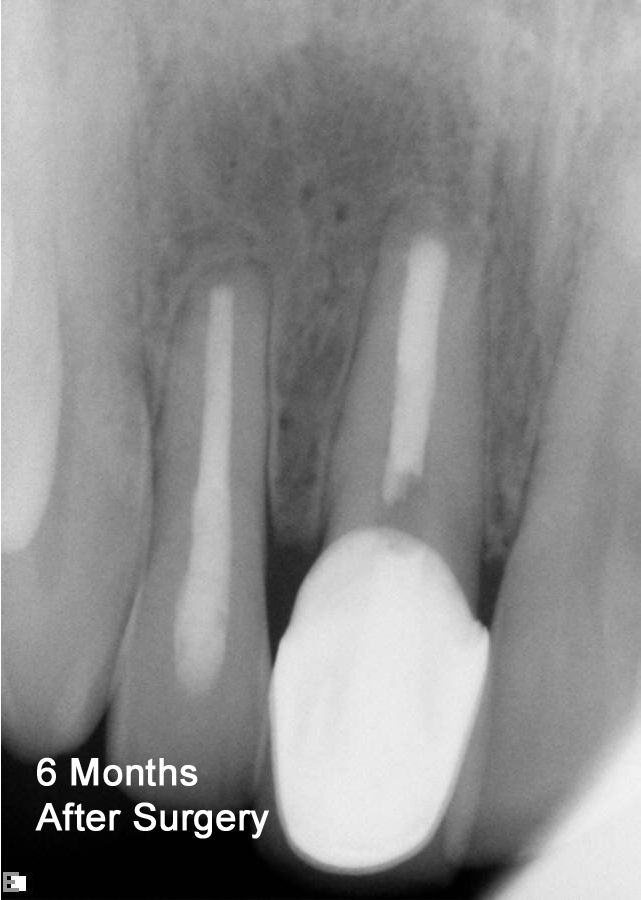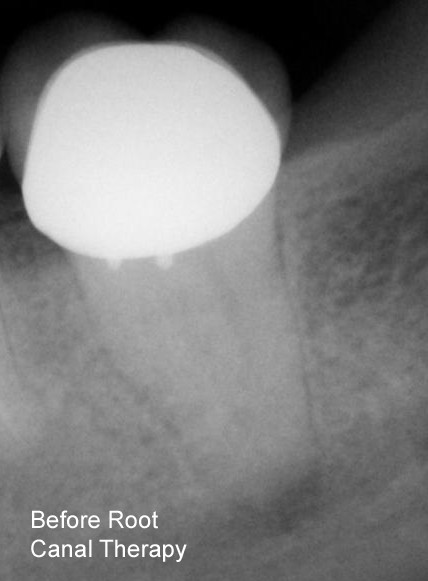Erich A. Dittmar DDS, MSD
810-225-9630
810-225-9630
10415 E. Grand River Rd Suite 400
Brighton, MI 48116
Brighton, MI 48116
Specialist in Root Canal Therapy
All teeth have a hollow space inside them where nerves and blood vessels reside. When teeth experience decay, cracks, a history of many fillings, trauma, or other sources of stress, bacteria have an opportunity to enter the hollow space of the tooth. Once bacteria or irritants gain entrance to this space, the body cannot get enough blood into the tooth to resolve this condition, and the nerve may begin to degenerate. The tooth becomes painful when this happens. Eventually, bacteria will leak out the tip of the root of the tooth, and an abscess may develop, causing swelling and pain. Root canal therapy is designed to resolve or prevent this situation. The only other treatment alternative to a root canal is extraction of the tooth.
The basic premise of root canal treatment has two parts. First, clean out the hollow space inside the tooth in an attempt to get rid of the invading bacteria, irritants, and damaged nerve. Second, to seal off the cleansed hollow space in an effort to prevent the return of bacteria or irritants into the area. Usually, both steps may be done during a single appointment; however, more than one appointment may be necessary in certain cases. In order to achieve both these steps, an access hole must be made in the tooth. Our office will place a temporary filling in this access. After root canal therapy is completed, it is essential that you return to your general dentist for final restoration of the access opening. We suggest crowns as the final restoration for molar and premolar teeth.
The basic premise of root canal treatment has two parts. First, clean out the hollow space inside the tooth in an attempt to get rid of the invading bacteria, irritants, and damaged nerve. Second, to seal off the cleansed hollow space in an effort to prevent the return of bacteria or irritants into the area. Usually, both steps may be done during a single appointment; however, more than one appointment may be necessary in certain cases. In order to achieve both these steps, an access hole must be made in the tooth. Our office will place a temporary filling in this access. After root canal therapy is completed, it is essential that you return to your general dentist for final restoration of the access opening. We suggest crowns as the final restoration for molar and premolar teeth.
More than 90% of cases done by an endodontist respond to root canal treatment. For cases that do not respond, it does not necessarily mean the tooth is lost. In some most unresponsive cases, endodontic surgery can resolve the problem. In a very small amount of cases, no amount of treatment will produce satisfactory results. We recommend treatment only when we believe it will be successful.
Endodontics is the specialty field in dentistry dedicated solely to root canal treatments and related microsurgical procedures. Literally, Endo means “inside” and dontics means “tooth.” Endodontists, the practitioners of endodontics, are dentists who have pursued and additional training beyond dental school, two or more years, in order to specialize in this field. Endodontics is the only type of dentistry we practice. By referring you to us your dentist is displaying appropriate and responsible concern for your specific endodontic needs. We work with your general dentist as part of your dental team. We are excited to add our unique endodontic experience to your dental team.
What is Endodontics?
What is Root Canal Treatment?
Root Canal Treatment is Highly Successful


Kensington Valley Endodontics, PC
After completion of endodontic treatment or retreatment, you must return to your dentist to have a crown or other restoration placed on the tooth to protect and restore it to full function. It is normal to experience post-operative discomfort following endodontic treatment. However, symptoms should improve daily until your tooth starts to feel normal again. If you experience persistent or increasing pain or any swelling, please call our office. Occasionally additional measures or medications are necessary to assist in post-operative healing.
After Root Canal Treatment
Endodontic Surgery
Occasionally, a nonsurgical root canal procedure alone cannot save your tooth and surgery will be recommended. Endodontic surgery can be used to access structures and canals that are not clinically accessible with traditional root canal therapy. Surgery is used to circumvent obstructions in root canals, treat damaged root surfaces, or remove chronic infection or cysts in the bone surrounding the tooth. There are many surgical procedures that can be performed to save a tooth. The most common is called an apicoectomy. In this microsurgical procedure the gum tissue near the tooth is raised to see the underlying bone and to remove any inflamed or infected tissue. The very end of the root is also removed. A small filling may be placed to seal the end of the root canal and few stitches or sutures are placed to help the tissue heal. Over a period of months, the bone heals around the end of the root. Local anesthetics make the procedure comfortable, and most patients return to their normal activities the next day. Postsurgical discomfort is generally mild.